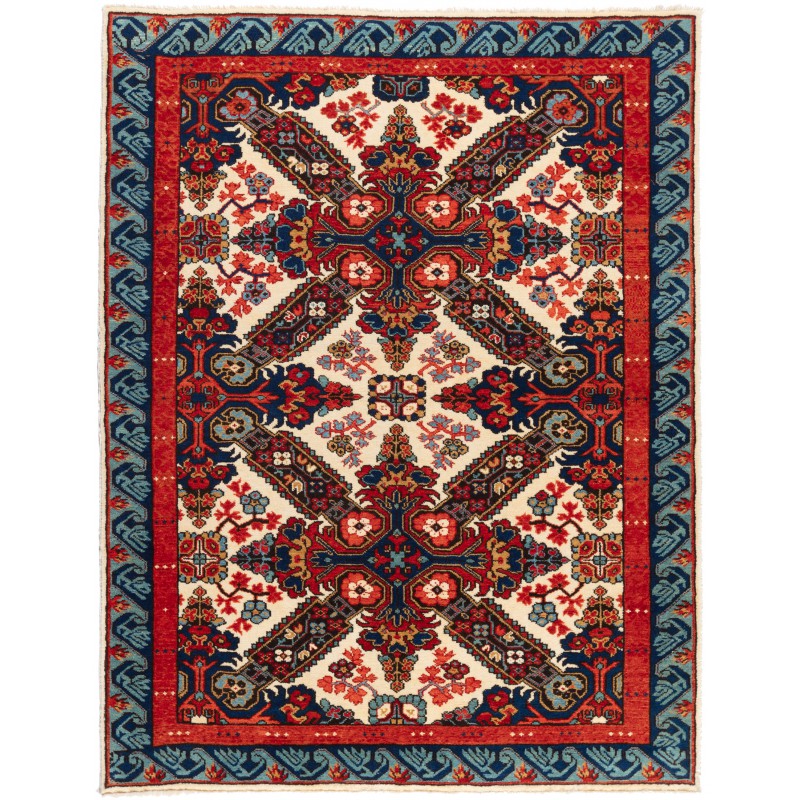
- Stock: In Stock
- Model: C50294
- サイズ: 115cm x 150cm
- Location: yildirim
この絨毯の情報は、Ian BennettとAziz Bassoulによる著書『Tapis du Caucase – Rugs of the Caucasus』(2003年、nr.90)、Ian Bennettによる『Oriental Rugs Volume 1 Caucasian』(1993年、pg.376)、およびE. Gans-Reudinによる『Caucasian Carpets』(1986年、pg.296)からのものです。これは19世紀末のクバ地域、セイチュール・クバ地方のクロスメダリオンデザインの絨毯です。セイチュール(セイチュールまたはセイクール)は、ダゲスタンの南約30キロメートルに位置するクバ地方で最も北に位置する町にちなんでいます。チチ絨毯と同様に、このグループは特定のボーダーの使用で特徴付けられており、通常は青と白の二色主体のパレットで描かれています。これらのボーダーはしばしば「走る犬」の変種とされていますが、主要なモチーフは「翼」と「胴体」の融合のように思われます。鳥の頭部の描写は特に明瞭です。また、「ジョージアン・ボーダー」とも呼ばれます。セイチュール絨毯の最も一般的なタイプは、比較的長い長さであり、幅は狭く、大きな「セント・アンドリュース・クロス」のモチーフと周囲のスタイライズされた花のパターンで構成されています。これはキリモフによるとIspigyulchichiまたは「白い花」と呼ばれるデザインです。構図の配置は通常、大きなクロスの単一の垂直列の形で行われますが、斜めの配置が知られています(Hali、vol. 1, no. 4, p. 38参照、このパターンは1:2:1:2:1:2:1の垂直読みとなります)。地の色は通常、濃い青または白です。ただし、セイチュール絨毯には全体的な花のデザインが頻繁に見られ、カラバフ絨毯に似た西洋風の花のデコレーションを持つよく知られたグループもあります。一部の場合、西洋風の花は主ボーダーにのみ現れ、セイチュールボーダーは外側のマイナーボーダーとして表示されます。この力強く独特なデザインと色彩の絨毯をセイチュール地域のクバに帰属させることは、現在ではかなり普遍的とされています。この絨毯のデザインは、当社のデザイナーによって解釈され、鮮やかな色彩が選ばれています。
The source of the rug comes from the book Tapis du Caucase – Rugs of the Caucasus, Ian Bennett & Aziz Bassoul, The Nicholas Sursock Museum, Beirut, Lebanon 2003, nr.90 and Oriental Rugs Volume 1 Caucasian, Ian Bennett, Oriental Textile Press, Aberdeen 1993, pg.376 and Caucasian Carpets, E. Gans-Reudin, Thames and Hudson, Switzerland 1986, pg.296. This is a cross medallion design rug from the late 19th century, Seichur Kuba region, Caucasus area. Seichur (Seichour or Seikhour) is named after the most northerly town of the Kuba region, about thirty kilometers south of Daghestan. Like Chichi rugs, this group is characterized by the use of a particular border, usually in a predominantly duochromatic palette of blue and white. Although often described as a variant of the ‘running dog’, the principal motifs of this border seem to be an amalgam of ‘wings’ and ‘torsos’; the depiction of a bird’s head seems particularly clear. It is also called the “Georgian border. The most common type of Seichur rug is fairly long eight to ten feet and narrow, with a composition consisting of a series of large ‘St. Andrew’s Cross motifs with surrounding systems of stylized flowers, a design which, according to Kerimov, is called Ispigyulchichi or ‘white flower’. The arrangement of the composition is usually in the form of a single vertical row of large crosses, although examples are known with a diagonal arrangement (cf. Hali, vol. 1, no. 4, p. 38 where this pattern reads vertically 1:2:1:2:1:2:1). Ground colors are usually dark blue or white. However, Seichur rugs with all-over floral compositions are frequently encountered and there is a well-known group with Western-style floral decoration similar to the Karabagh rugs. In some instances, the ‘western’ flowers appear only on the main border, the ‘Seichur’ border appearing as an outer minor border. The attribution of rugs with this powerful and distinctive design and colors to the Seichour region of Kuba now seems fairly universal. The design of the rug is interpreted by our designers, and vivid colors are chosen for this rug.
